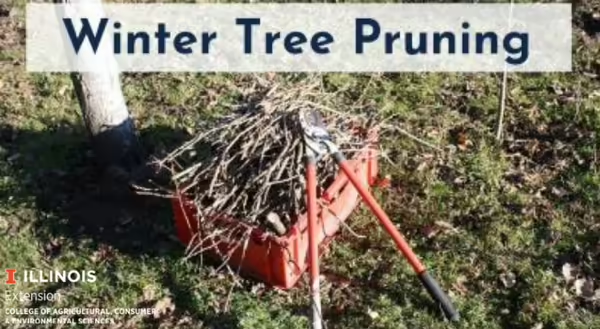
Before we know it, spring will be here. Before getting too busy planting the garden, make sure to take some time to prune your trees (if they need it). While the old adage may say, "prune when your pruners are sharp", most deciduous trees are best pruned while they are in full dormancy. In this part of the country, February or March is a good time to prune.
It is important that they are pruned while they are fully dormant. If pruned too early, and not fully dormant, they may produce new shoots that can be killed by cold temperatures. Another important reason to prune most deciduous trees during colder months, especially trees like oak and elms, is that pruning wounds can attract borers. These beetles can carry diseases such as oak wilt and Dutch elm disease.
Pruning in the winter also allows you to see the framework of the tree. This will make determining which branches and stems you want to remove easier. Start by pruning dead and dying parts of the plants first (this can be done at any point of the year, no need to wait for winter). After that, identify any problems you may see in the tree, such as crossed and/or rubbing branches (rubbing branches cause wounds that can allow diseases to enter), branches growing towards the center of the tree, branches with narrow crotch angles (these are more likely to break), multiple leaders, and branches that may pose hazards to people or property.
By eliminating potential problems in younger established trees you can avoid extensive, and potentially expensive repair work to older mature trees. If you have large mature trees that need to be pruned, it may be best to contact a certified arborist. They will have the necessary tools and safety equipment to safely prune large trees.
Having the proper tools to prune trees is also important. Some of the tools you may want are hand shears for small branches up to ¼" in diameter and lopping shears for branches up to 1 ½" in diameter. Pruning saws should be used for branches over 1" in diameter and pole pruners can be used to reach branches beyond your reach. Also, make sure your pruners are sharp. If your tools are sharp it will be easier to make the cuts and the cuts will heal better (dull tools are more likely to crush or tear instead of cut).
For many years it was recommended that pruning wounds should be sealed (painted) to prevent pathogens from entering and to prevent the wood from decaying. However, this is not the case. Research has shown that it is not as helpful as once believed. Often times the coating will crack, allowing moisture to get in and accumulate. This is an ideal environment for wood-rotting organisms. Trees will naturally heal the wound themselves (callusing) and sealing the wound actually slows this process down.
Good Growing Tip of the Week: If you're in need of a certified arborist, the International Society of Arboriculture has an online directory of certified arborists. It can be found at treesaregood.org.
Signup for our emails! Want to get notified when new Good Growing posts are available? SIGN ME UP
MEET THE AUTHOR
Ken Johnson is a Horticulture Educator with University of Illinois Extension, serving Calhoun, Cass, Greene, Morgan, and Scott counties since 2013. Ken provides horticulture programming with an emphasis on fruit and vegetable production, pest management, and beneficial insects. Through his programming, he aims to increase backyard food production and foster a greater appreciation of insects.